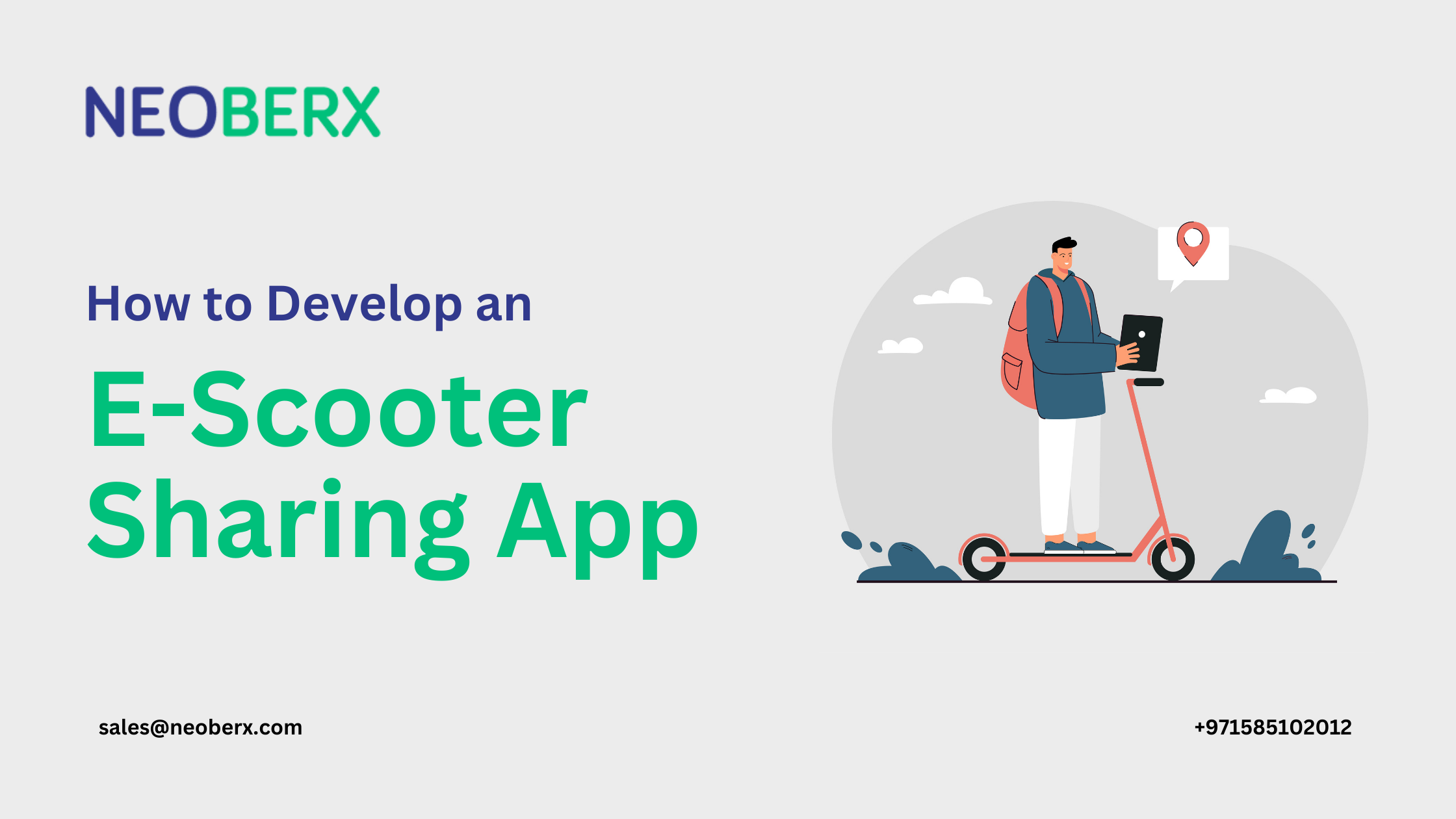Introduction:
Urban transportation has changed as a result of the growth of e-scooter apps, which offer a practical and sustainable mode of transportation. With scooter sharing apps, people can now travel around cities more cheaply and effectively than with more conventional forms of transportation. With the growing demand for sustainable urban mobility solutions, e-scooter sharing Apps are ushering in a more connected and accessible future.
Shared electric scooter services have become extremely popular in recent years. Major companies such as Bird, Lime, Spin, Lyft, and Uber have launched fleets of dockless e-scooters that riders can use to navigate cities via mobile apps.
Key Features of E-Scooter Sharing Apps:
E-scooter sharing apps have a number of important features that enable their core functionality:
GPS Tracking:
GPS tracking allows the app to monitor the real-time location of its e-scooter fleet. The app uses GPS to show users the location of the nearest available e-scooters for rental. GPS also enables the company to detect any unauthorized movements of its e-scooters, preventing theft and misuse.
Ride Tracking:
Ride tracking uses GPS to trace the start point, end point, distance, route, speed, and duration of every ride. This provides valuable data and analytics on usage patterns. Ride tracking enables features like calculating the fare based on distance traveled. It also aids fleet management by identifying heavily used areas to optimize e-scooter distribution.
Payment Processing:
Integrated payment processing allows users to pay for e-scooter rides directly from the app. This includes credit card support, mobile wallet integration, promotional codes, and coupons. Payment processing is critical for a seamless user experience, from rental to payment. The app securely handles all transactions without the need for cash payment.

Ready to Transform Urban Mobility? Start Your E-Scooter App Journey Now!
Components of an E-Scooter Sharing App
An e-scooter sharing app requires three main components to operate effectively:
User App:
- The user app allows riders to find, reserve, unlock, and pay for nearby e-scooters. Key features of the user app include:
- Location tracking to show available e-scooters nearby. Uses GPS and geo-fencing.
- Reservation system to hold an e-scooter for a short time. Prevents other users from taking it.
- QR code or Bluetooth unlocking to release the e-scooter. Better than keys which can get lost.
- In-app wallet to store payment information and process trip charges. Allows cashless rides.
- Trip tracking to calculate distance, time and cost of each trip. Generates usage data.
- User profiles, accounts and ride history for a personalized experience.
Admin App:
- The admin app allows the e-scooter company to manage their fleet operations. Key admin app features:
- Real-time maps to view locations of all e-scooters and user density. Critical for rebalancing.
- Alert system for scooters with low battery, damage or vandalism. Helps remove unsafe vehicles.
- Remote locking capability to discourage theft and misuse. Improves fleet security.
- Usage analytics to optimize operations and pricing. Provides data insights.
- Customer support tools like chat, calls and in-app messaging. Improves user experience.
Backend & APIs
- The backend ties together the user and admin apps while also integrating with external systems like payment gateways. It provides:
- Account management for user profiles, wallets, and ride history. Stores critical user data.
- Payment processing to deduct trip fees seamlessly via APIs. Enables cashless system.
- Real-time location tracking of scooters using APIs like Google Maps. Shows nearby availability.
- Predictive analytics to forecast demand spikes and optimize supply. Balances vehicle distribution.
- Administration portal for managing fleets, support tickets, and usage trends. Centralized control.
- Data storage in the cloud to ensure reliability and scalability. Supports large fleets.
- REST APIs for integration with other apps, tools, and platforms. Allows customization.
- The backend handles the logical heavy-lifting to run e-scooter operations smoothly. A well-designed system ties the app components together into an efficient service.
UI/UX Design Considerations:
Designing an intuitive user interface and smooth user experience is crucial for the success of an e-scooter sharing app. Some key UI/UX elements to consider include:
- Simple registration and login: Reduce friction by allowing users to sign up and login quickly with just a phone number or social login. Use progressive disclosure to only ask for more info once they want to ride.
- Intuitive scooter location: Display nearby scooters on a map view and list view sorted by distance. Allow filtering by charge level. Tap to see more details.
- Ride unlocking: Use NFC or Bluetooth to instantly unlock scooters upon approach. Provide clear visible instructions for unlocking.
- Ride tracking: Show riding time, distance, speed, battery level, safety tips during ride. Automatically pause ride and fare if idle for a period.
- Parking: Instruct users how to properly end a ride and park. Take photo to validate proper parking.
- User profiles: Allow viewing history, payment, promos, support tickets. Set favorite locations.
- Safety and regulations: Quiz new users on riding rules. Show safety tutorial. Include helmet selfies and tips.
- Payments: Save payment methods to minimize hassle. Clearly show ride fare estimates and totals.
- Notifications: Provide status notifications on scooter availability, ride start/end, promotions, account changes.
- Support: Include in-app chat, FAQ, and community help features. Allow easy ticket creation.
The app should provide a seamless experience from signup to riding to parking. Reduce complexity and clutter in the interfaces. Use animations and loading indicators for mode changes. Focus on core use cases and frequently used features. Test with users and gather feedback early and often. Iterative design improvements can maximize customer satisfaction.
Market Research and Competitor Analysis of E-Scooter Sharing App
Before developing an e-scooter app, it is crucial to conduct thorough market research and competitor analysis. This involves:
- Researching potential target markets and cities. Factors to consider include city size, demographics, transportation infrastructure, regulations, climate, etc. Focus on dense urban areas where short trips are common.
- Analyzing successful e-scooter companies like Bird and Lime. Study their business models, pricing, operations, fleets, etc.
- Identifying gaps, opportunities and differentiators. For example, you may decide to focus on a niche market or optimize operations in some way.
- Surveying existing and potential customers on needs and preferences. Get a sense of demand, pricing sensitivity and feature requirements.
- Estimating market size in potential launch cities. Analyze factors like population, commute data, climate, etc. to model demand.
- Researching city regulations surrounding e-scooters. Stay updated on rapidly evolving rules.
- Monitoring industry trends like new hardware models or rental vs ownership approaches.
Thorough market research and competitor analysis provides key insights to inform an e-scooter app development strategy and roadmap. It helps identify the most viable markets, optimize operations, and differentiate your offering. Ongoing research is crucial even post-launch to stay ahead of the competition.
Custom E-Scooter Sharing App Development:
Developing an e-scooter app involves key decisions around whether to build native apps for each platform like iOS and Android, or use a cross-platform framework like React Native. Here are some considerations:
Native Apps:
- Offers the best performance, responsiveness, and ability to leverage unique device capabilities
- Requires developing expertise in multiple code bases like Swift for iOS and Kotlin for Android
- Allows fully customizing UI for each platform
- Can access full functionality of SDKs provided by platform vendors
- Requires maintaining separate code bases
Cross-Platform Apps
- Write once and deploy to multiple platforms, reducing development effort
- Uses common web development skills like JavaScript, React Native
- Provides mostly consistent UI across platforms
- May have performance limitations or less responsive UX
- Limited access to some unique platform capabilities and SDKs
For an e-scooter app, native apps are recommended to provide the smoothest UX and leverage device capabilities like GPS, but cross-platform can work too.
The Tech Stack Typically Involves to Build E-Scooter Sharing App:
- Frontend: React Native, Swift, Kotlin
- Backend: Node.js, Django, Ruby on Rails
- Database: MongoDB, PostgresSQL
- Cloud: AWS, Azure, Google Cloud
Cost of Developing An e-Scooter Mobile App
The cost to develop an e-scooter sharing app can vary greatly depending on the features, complexity, design, and location of the development team. However, here is a general cost breakdown:
Minimum Viable Product
An MVP e-scooter app with basic functionality like user profiles, scooter tracking, and payment processing can be developed for $30,000 – $75,000. This would include:
- Backend development – $15,000-$30,000
- Frontend/app development – $10,000-$25,000
- Project management, QA, UX/UI – $5,000-$20,000
Additional Features:
Adding more complex features will increase costs such as:
- Integrations with third-party apps and services like maps, weather, etc. – $5,000-$15,000
- Advanced analytics and business intelligence – $5,000-$10,000
- Enhanced security features like facial recognition – $5,000-$15,000
- Gamification and promotional features – $5,000-$10,000
Location of the developers can also impact costs. For example, Eastern European or Indian firms may charge $25-$50/hour while US firms may charge $100-$150/hour.
So a full-featured e-scooter app could cost $100,000 to $250,000+ depending on the specific requirements. It’s critical to focus on core functionality in the MVP, then scale up from there.
Conclusions
Embrace the future of urban mobility by taking charge of your own e-scooter app development app today! With the rise of e-scooter sharing services and the growing demand for convenient and eco-friendly transportation options, developing your own e-scooter app can be a lucrative opportunity.
By investing in an e-scooter app development application, you can tap into the booming market of urban commuters looking for efficient and sustainable ways to get around. Your app can offer users a convenient way to locate and unlock nearby e-scooters, track their rides, and make secure payments – all with just a few taps on their smartphones.
With the right features and user-friendly interface, your e-scooter app has the potential to revolutionize urban mobility in your city. Whether you’re targeting busy professionals, students, or tourists, providing them with a reliable and affordable transportation option can set your app apart from competitors.
So don’t miss out on this opportunity to shape the future of urban mobility. Start your e-scooter app development project today and be at the forefront of this exciting trend!



